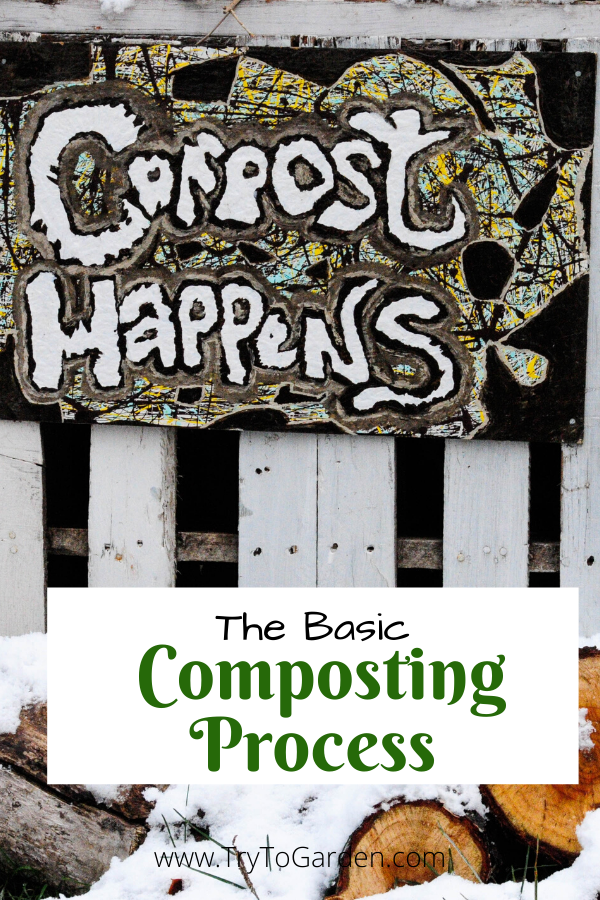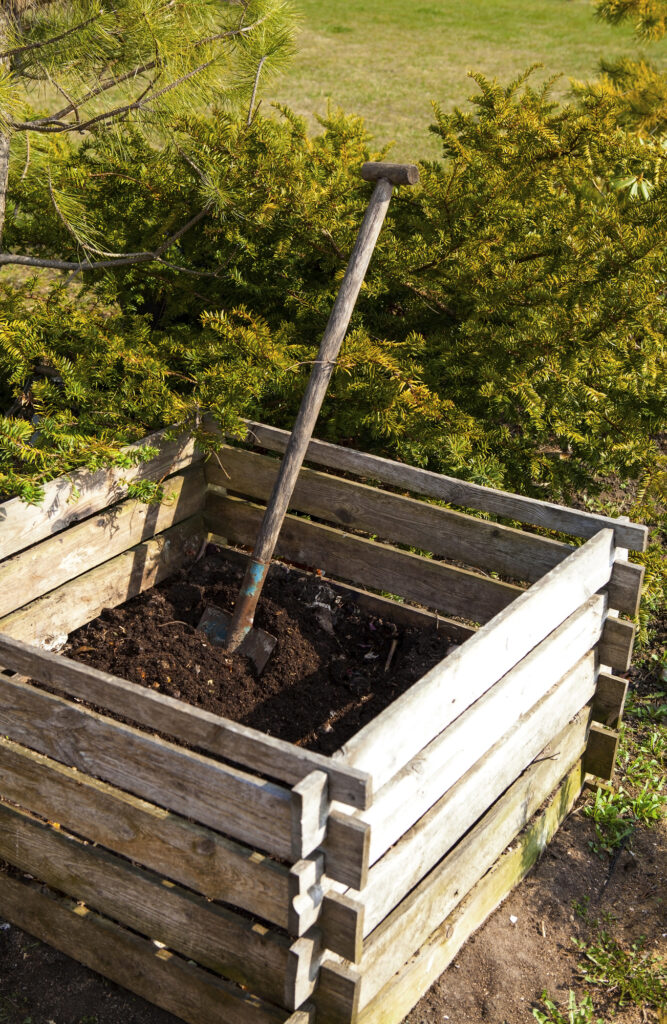This post contains affiliate links, which means I will make a commission at no extra cost to you should you click through and make a purchase. As an Amazon Associate I earn from qualifying purchases.
New to composting and not sure where to start? These tips for backyard composting made easy will help you turn food waste into garden soil with barely any work!

Why I Love Composting
If you have been thinking about starting a compost pile for a while but don't know where to start, I have put together some basic dos and don'ts for you. Before you even make it outdoors to your large compost pile, it begins in your home.
Not only will composting help you reduce your household food waste ( not to mention save on garbage bags), but you will also reduce the amount of waste in landfills which is important to help fight climate change. Home composting allows you to create rich, wonderful soil that will benefit small or large gardens and container plants.
Another great thing about making your own fresh compost is that compost piles don't require a lot of room to start or maintain- a small corner in your yard is all you need. You can use old tires to hold your compost as well.
Here are a few basic backyard composting tips to help you turn all your organic materials into rich, nutritious plant food.

What is the simplest way to compost?
Learning how to make compost from organic material is not that difficult. While the process may seem intimidating at first, it is actually quite simple. The basics of composting involve providing a good mix of the right ingredients and creating an environment that allows the decomposition process to take place.
The simplest way to start composting is by using a compost bin or container. These can be purchased at garden stores or online, or you can also make your own with materials like wood pallets, wire mesh, or even a simple plastic bin with holes drilled into it.
Once you have your compost bin or container, you'll need to start adding the right materials. This includes a mix of "green" materials such as grass clippings, vegetable scraps, and coffee grounds, and "brown" materials like dry leaves, shredded newspaper, and cardboard.
Composting is a simple process that will take place whether you help it along or not, however, there are a few things to keep in mind to avoid unpleasant odors and ensure that your compost pile doesn't attract animals.

What Organic Waste Gets Composted
You will need an assortment of organic materials, from kitchen waste like food scraps to pine needles and grass clippings.
Food scraps and kitchen waste
Your compost pile starts in the kitchen so make sure you invest in a good countertop compost bin to collect food scraps. This will make up part of the green layer of your compost pile. I prefer to use a compost container with a lid and filter. I have a ceramic 1-gallon compost bin. sitting on my counter for scraps, I take it out about twice a week and add it to my outdoor compost.
Kitchen scraps that are great for composting at home include :
- Fruits and vegetables
- Vegetable peelings
- Eggshells
- Coffee grounds and filters
- Tea bags (make sure they are made of natural materials)
- Nutshells
- Banana peels
Don't compost meat, dairy products, or oils as these can attract pests to your pile. You also don't want to add pet waste or any plants that have diseases.
Yard Waste From Your Outdoor Space
Now moving outdoors there are quite a few compost materials you can and should add to your compost. Brown materials include; dry brown leaves and grass, straw, small amounts of ash, sawdust, and dried plant stalks.
Ideally, you want a little more brown than green in your compost. If you prefer to have your compost contained, you can invest in a compost bin. I have a Tumbling Composter which makes it easy to turn the compost regularly.
Dry materials that are great for making compost include:
- Leaves
- Straw
- Twigs and branches
- Dry grass clippings
- Wood chips
- Paper products like brown paper bags
Don't compost weeds (you don't want weed seeds in your compost), diseased plants, or any yard clippings that have been treated with pesticides.

The Secret to a Healthy Compost Pile: Carbon/Nitrogen Ratio
The ideal ratio for a compost pile is 3 parts brown waste to 1 part green waste. This balance is essential for the microbes that break down the materials to thrive.
If your compost pile smells bad, it could mean it has too much nitrogen (from green waste) and not enough carbon (from brown waste). Simply add more brown waste to correct this.
On the other hand, if your compost pile is not breaking down quickly, it may have too much carbon and not enough nitrogen. In this case, add more green waste to balance it out.

The Basic Composting Process
Now that you know the green and brown materials that go into your compost bin, how do you start composting at home?
Once you have your compost pile started, there are a few things you can do to help it break down faster:
- Choose the right spot: Select a well-drained spot in your backyard that receives partial sunlight. Avoid areas prone to flooding or extreme heat.
- Aerate the compost: Turn the pile regularly (every 2-3 weeks) to aerate it and speed up decomposition
- Water sparingly: Keep the pile moist, but not too wet (like a squeezed-out sponge)
- Crush or chop materials: Chop up larger materials before adding them to the pile to help them break down faster
- Add beneficial organisms: Adding a compost starter can also help speed up the process
- Monitor Temperature: A healthy compost pile heats up as it decomposes. Use a compost thermometer to ensure the temperature is between 130-160°F (54-71°C) for optimal breakdown.
- Be Patient: Composting takes time. Depending on conditions and methods, it can take several months to a year for compost to be ready. Be patient and continue to tend to your pile.
Remember that successful composting involves a balance of factors, including the right mix of materials, moisture, and aeration. Adjust your practices as needed and enjoy the benefits of nutrient-rich compost for your garden.

How to Know if My Compost Pile is Working?
So, you have added in your organic matter and are impatiently watching to see if your kitchen scraps, food waste, and grass clippings are going to turn into that black gold you keep hearing about. How do you know if your home composting is successful?
While you will have to be patient, here are a few signs that you are composting correctly:
- A healthy compost pile will heat up as it decomposes. Use a compost thermometer to check the temperature of your pile.
- If you can see steam rising from your compost pile as you turn it, that's a good sign that the breakdown process is happening.
- As organic materials break down, they become unrecognizable. If you can still see distinct food scraps or other materials, your compost is not ready yet.
- A well-maintained compost pile should have a pleasant earthy smell. If it smells bad, it could be an indication of too much moisture or lack of air circulation.
If you can see that things look right, just be patient. Good compost takes a while to make. Once things start breaking down, you know that you are on the right track.

Using Your Finished Compost
After 3-6 months, your compost should be ready to use in your garden or potted plants. It should have a dark brown, crumbly texture and smell earthy. Spread a layer of compost on top of your garden soil to add nutrients and improve the overall health of your plants.
Composting is easy, good for the environment, and can save you money in the long run by reducing your need for store-bought fertilizers. You can use it to grow a bucket garden or use it to start a butterfly garden.
Happy Composting and let me know if you are planning on or are already composting! Once you master the basic compost pile, you are ready to dive into worm bins and Bokashi Composting.
Other posts you may like:
